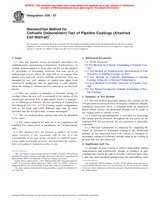Potrebujeme váš súhlas na využitie jednotlivých dát, aby sa vám okrem iného mohli ukazovať informácie týkajúce sa vašich záujmov. Súhlas udelíte kliknutím na tlačidlo „OK“.
ASTM G95-07
Standard Test Method for Cathodic Disbondment Test of Pipeline Coatings (Attached Cell Method)
Automaticky preložený názov:
Štandardná skúšobná metóda pre katódovej Disbondment Test potrubia Coatings ( Attached Method Cell )
NORMA vydaná dňa 1.7.2007
Informácie o norme:
Označenie normy: ASTM G95-07
Poznámka: NEPLATNÁ
Dátum vydania normy: 1.7.2007
Kód tovaru: NS-57885
Počet strán: 4
Približná hmotnosť: 12 g (0.03 libier)
Krajina: Americká technická norma
Kategória: Technické normy ASTM
Anotácia textu normy ASTM G95-07 :
Keywords:
anode, attached cell, cathodic, disbondment, electrical stress, electrolyte, salt bridge, ICS Number Code 23.040.99 (Other pipeline components)
Doplňujúce informácie
| Significance and Use | ||||||||||
|
Damage to pipe coating is almost unavoidable during transportation and construction. Breaks or holidays in pipe coatings may expose the pipe to possible corrosion since, after a pipe has been installed underground, the surrounding earth will be moisture-bearing and will constitute an effective electrolyte. Applied cathodic protection potentials may cause loosening of the coating, beginning at holiday edges. Spontaneous holidays may also be caused by such potentials. This test method provides accelerated conditions for cathodic disbondment to occur and provides a measure of resistance of coatings to this type of action. The effects of the test are to be evaluated by physical examinations and monitoring the current drawn by the test specimen. Usually there is no correlation between the two methods of evaluation, but both methods are significant. Physical examination consists of assessing the effective contact of the coating with the metal surface in terms of observed differences in the relative adhesive bond. It is usually found that the cathodically disbonded area propogates from an area where adhesion is zero to an area where adhesion reaches the original level. An intermediate zone of decreased adhesion may also be present. Assumptions associated with test results include: 4.3.1 Maximum adhesion, or bond, is found in the coating that was not immersed in the test liquid, and 4.3.2 Decreased adhesion in the immersed test area is the result of cathodic disbondment. Ability to resist disbondment is a desired quality on a comparative basis, but disbondment in this test method is not necessarily an adverse indication of coating performance. The virtue of this test method is that all dielectric-type coatings now in common use will disbond to some degree, thus providing a means of comparing one coating to another. The current density appearing in this test method is much greater than that usually required for cathodic protection in natural environments. |
||||||||||
| 1. Scope | ||||||||||
|
1.1 This test method covers accelerated procedures for simultaneously determining comparative characteristics of coating systems applied to steep pipe exterior for the purpose of preventing or mitigating corrosion that may occur in underground service where the pipe will be in contact with natural soils and will receive cathodic protection. They are intended for use with samples of coated pipe taken from commercial production and are applicable to such samples when the coating is characterized by function as an electrical barrier. 1.2 This test method is intended to facilitate testing of coatings where the test cell is cemented to the surface of the coated pipe specimen. This is appropriate when it is impractical to submerge or immerse the test specimen as required by Test Methods G 8, G 42, or G 80. Coating sample configuration such as flat plate and small diameter pipe may be used, provided that the test procedure remains unchanged. 1.3 This test method allows options that must be identified in the report. 1.4 The values stated in SI units are to be regarded as the standard. The values given in parentheses are for information only. This standard does not purport to address all of the safety concerns, if any, associated with its use. It is the responsibility of the user of this standard to establish appropriate safety and health practices and determine the applicability of regulatory limitations prior to use. |
||||||||||
| 2. Referenced Documents | ||||||||||
|




 Cookies
Cookies
